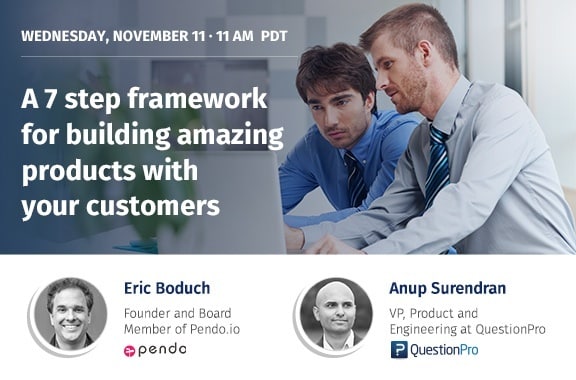 Reading Time: 3 minutes read
Reading Time: 3 minutes readThis week QuestionPro held another successful webinar when Anup Surendran, VP Product and Engineering here at QuestionPro was discussing “A 7 Step Framework For Building Amazing Products With Your Customers” with a product expert Eric Boduch. They explained each of the seven steps companies should follow in order to move from building good enough products to building great products.
Eric is the founder and VP of Marketing at Pendo.io, a venture-backed software company, that recently raised 11$ million. He has been involved with both startup and publicly traded software companies in senior management positions for over 20 years.
Before joining QuestionPro, Anup was providing solutions to many of Fortune 500 companies in financial and retail space, as well as rolling out impressive, large-scale customer loyalty programs.
Here are the slides that were shared during the webinar.
When doing business we are naturally inclined to think about money first, but what companies should really be thinking about is – is my product solving any pain or instead, is using my product a pain?
The customer-centric framework that Anup calls OPTIMAL (Acronyms for Observe, Purpose, Transparent, Innovate, Motivate, Accountable, Lovable) describes the areas to be addressed for building successful products.
A good place to start is Observation. Repeatedly observing prospects and customers in various settings can help improve an existing product and lead to new ideas. Observation allows stepping in other people’s shoes and capturing everything they do. That data can then help make future decisions or solve problems that have not yet occurred. That is why it is wise to capture all the data even, if not actively tracking or reporting on it.
Next step is to find the Purpose. Every customer goes through a journey with a destination in mind. Therefore, data should be sliced and diced to find that purpose. Do successful customers use the product in different ways than unsuccessful customers? Do first few weeks of using a product set the tone for whether the customer will eventually be successful or not?
Being Transparent with customers about the challenges you are facing, the product roadmap and where you are in terms of delivering your commitments will strengthen your relationship between you and the customer.
Both, customers and employees have to be involved in the Ideation process. Innovation happens even if it is not recognized. For example, when customers do workarounds, they hack products to get to the result through a different path. That data should be analyzed to identify opportunities while maintaining speed and relevance.
Customer behavior is a function of Motivation x ability x trigger. A great product person will monitor customer behavior and break it down into theses three elements. Then it will become evident what stalls customer from using your product.
To be truly customer-centric, action needs to be taken to demonstrate your Accountability, in cases where a problem is brought to your attention. Respond directly showing your awareness and agility.
To make a product Lovable, it should not be viewed merely as a set of features and functions. Both experts drew attention to the shift in the product landscape – no longer are features assessed per se. It is the whole user experience that is regarded highly. Onboarding users at the beginning, educating them on how to become successful and informing them as your product changes – are all part of the overall product experience. At QuestionPro levels of customer, happiness are being measured by running a Net Promoter Survey question type. After completing a task within a product, we ask for their level of satisfaction in terms of product usage.
To watch the full webinar, click on the video below:




















